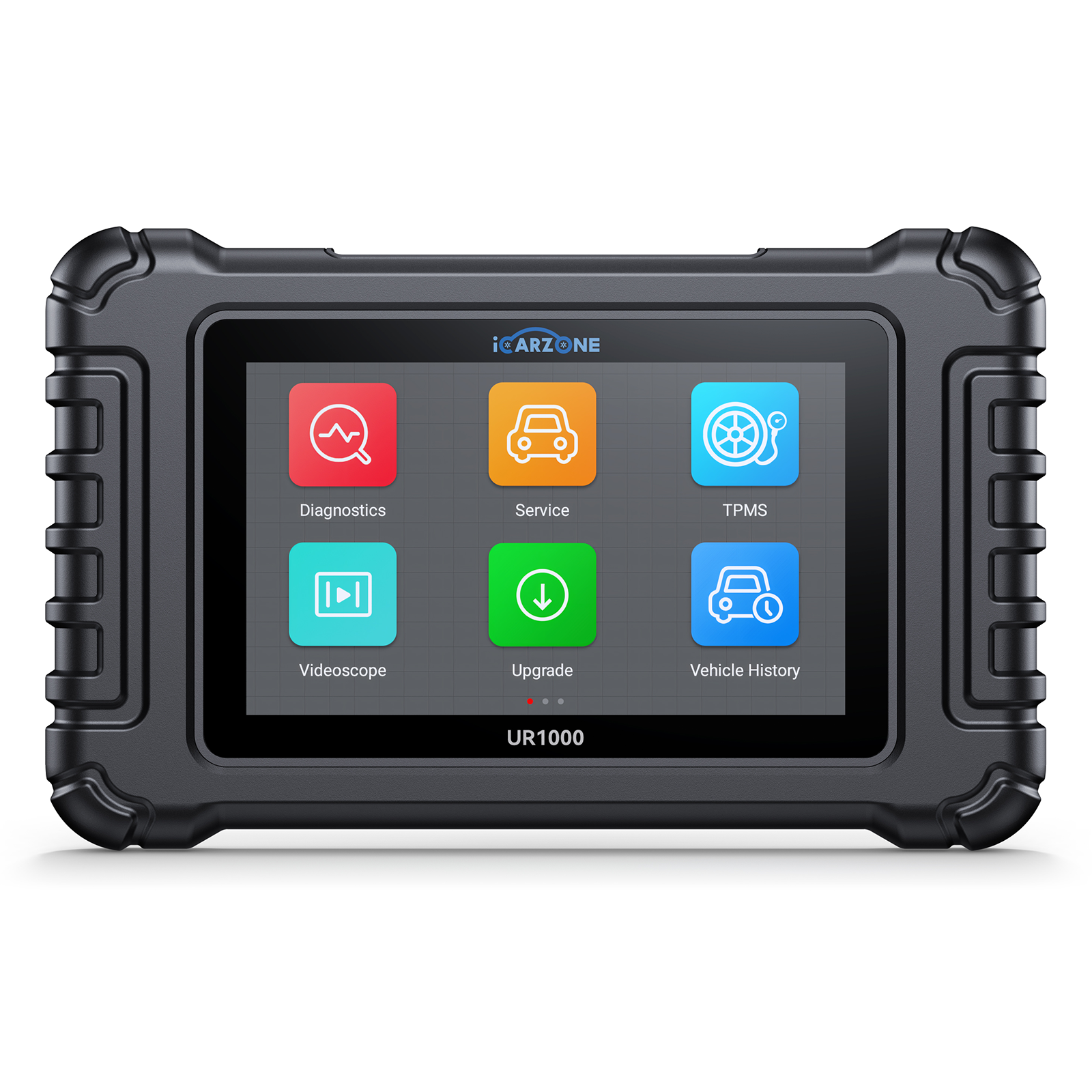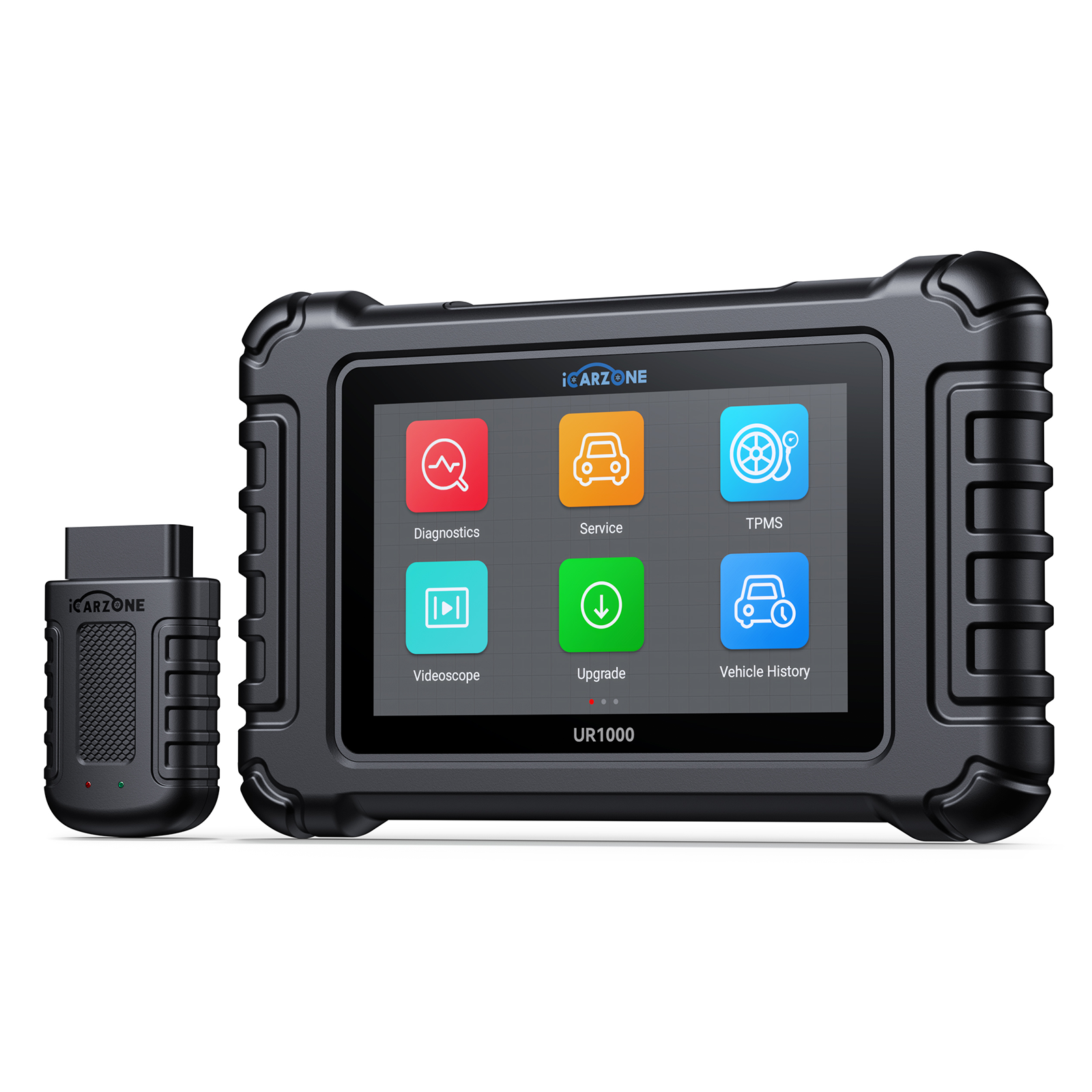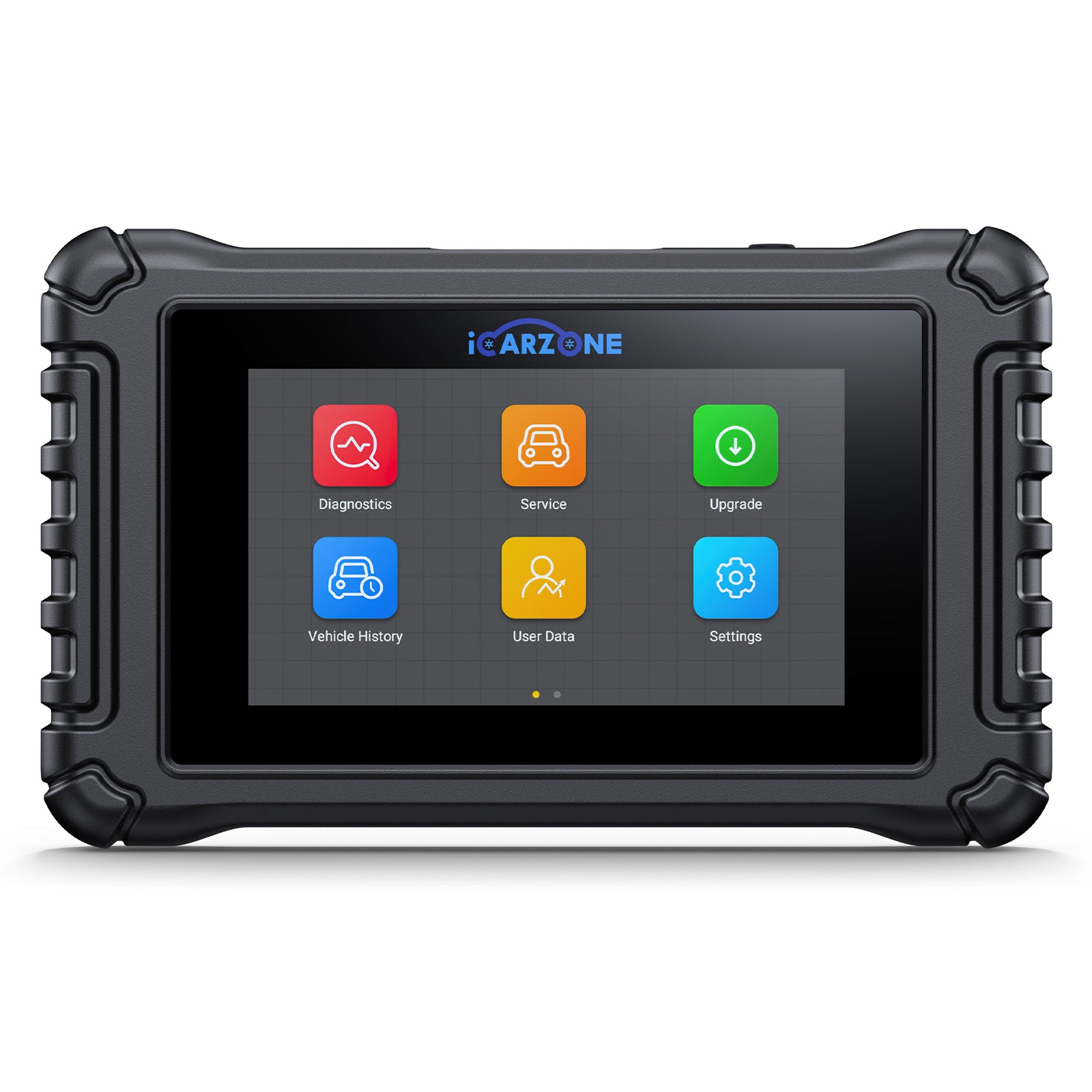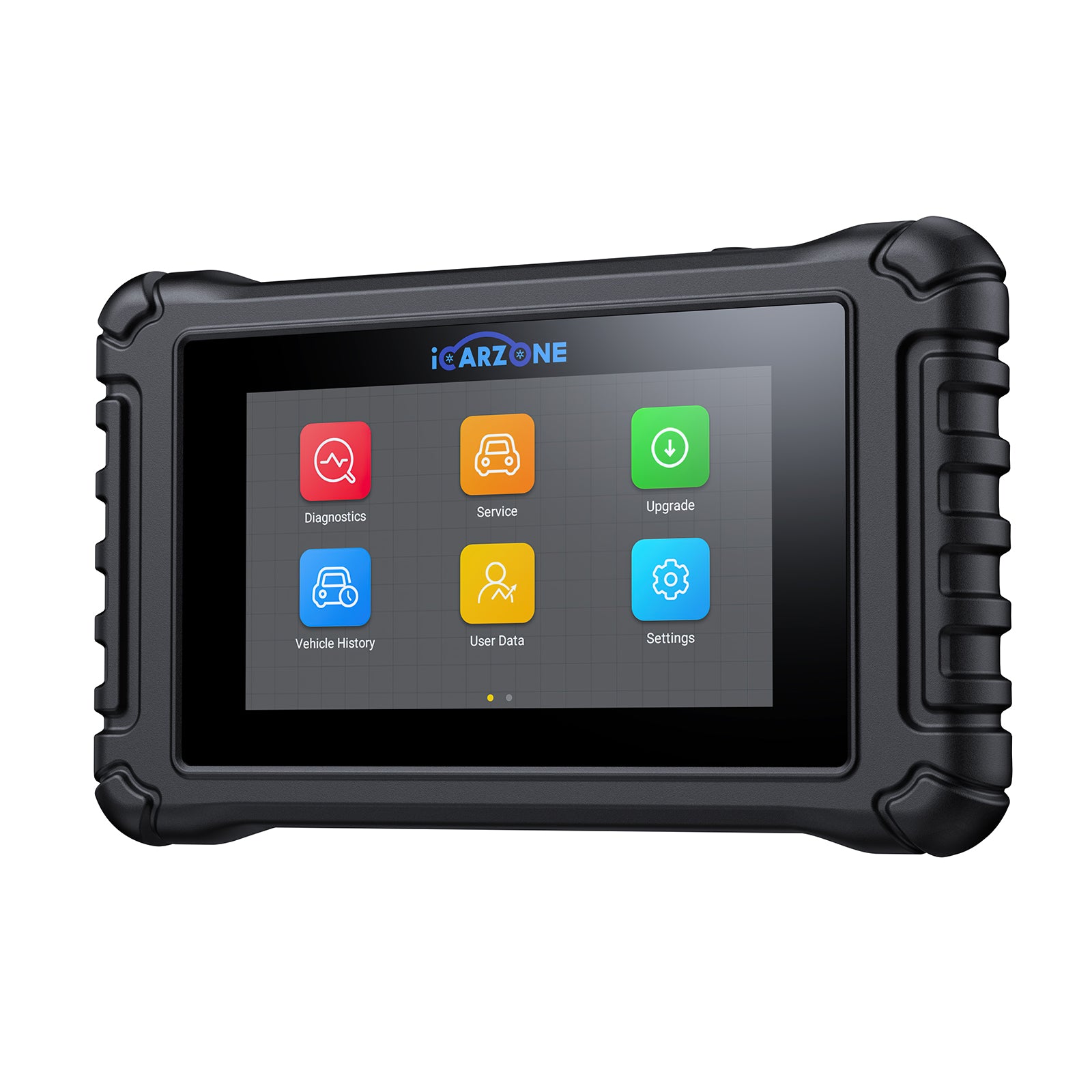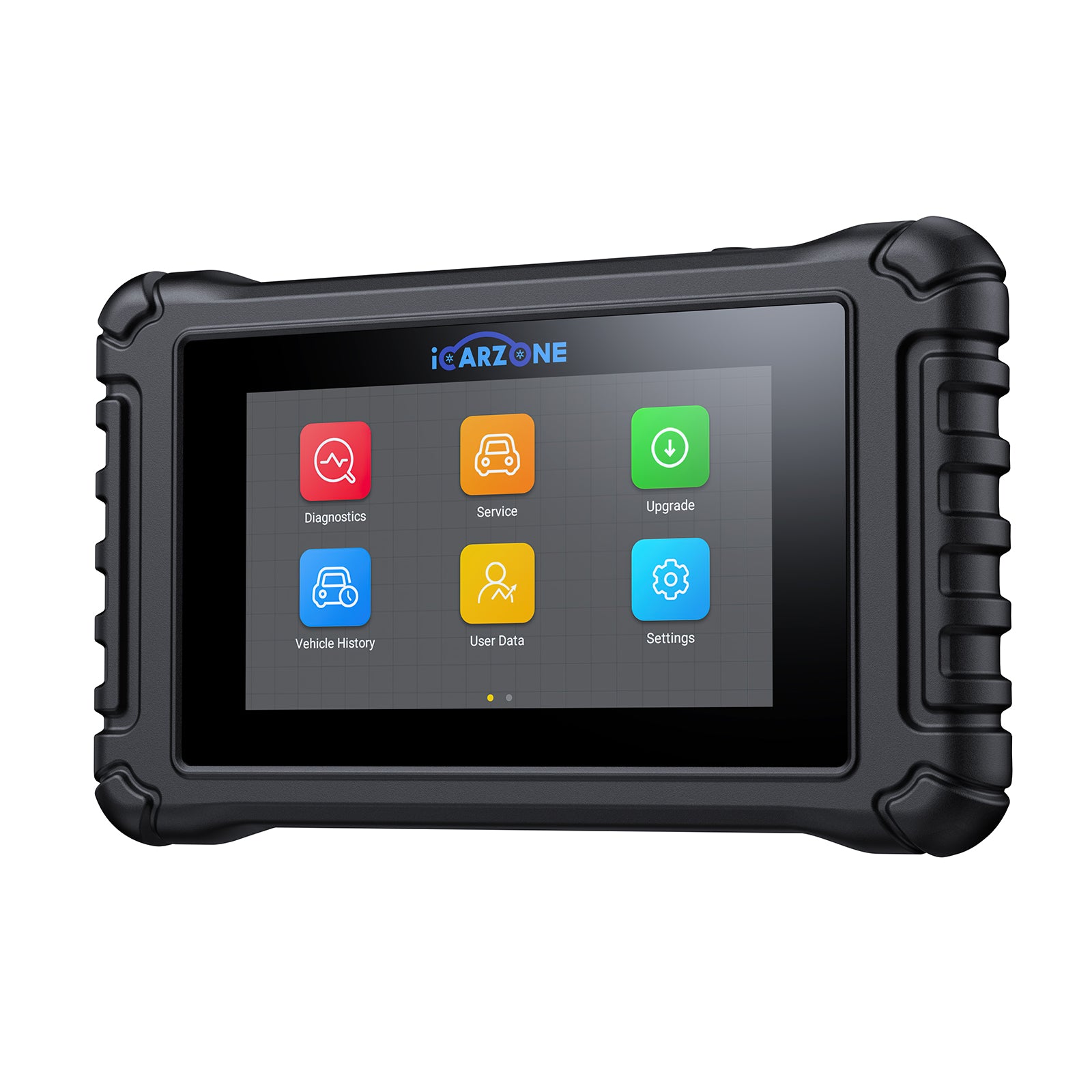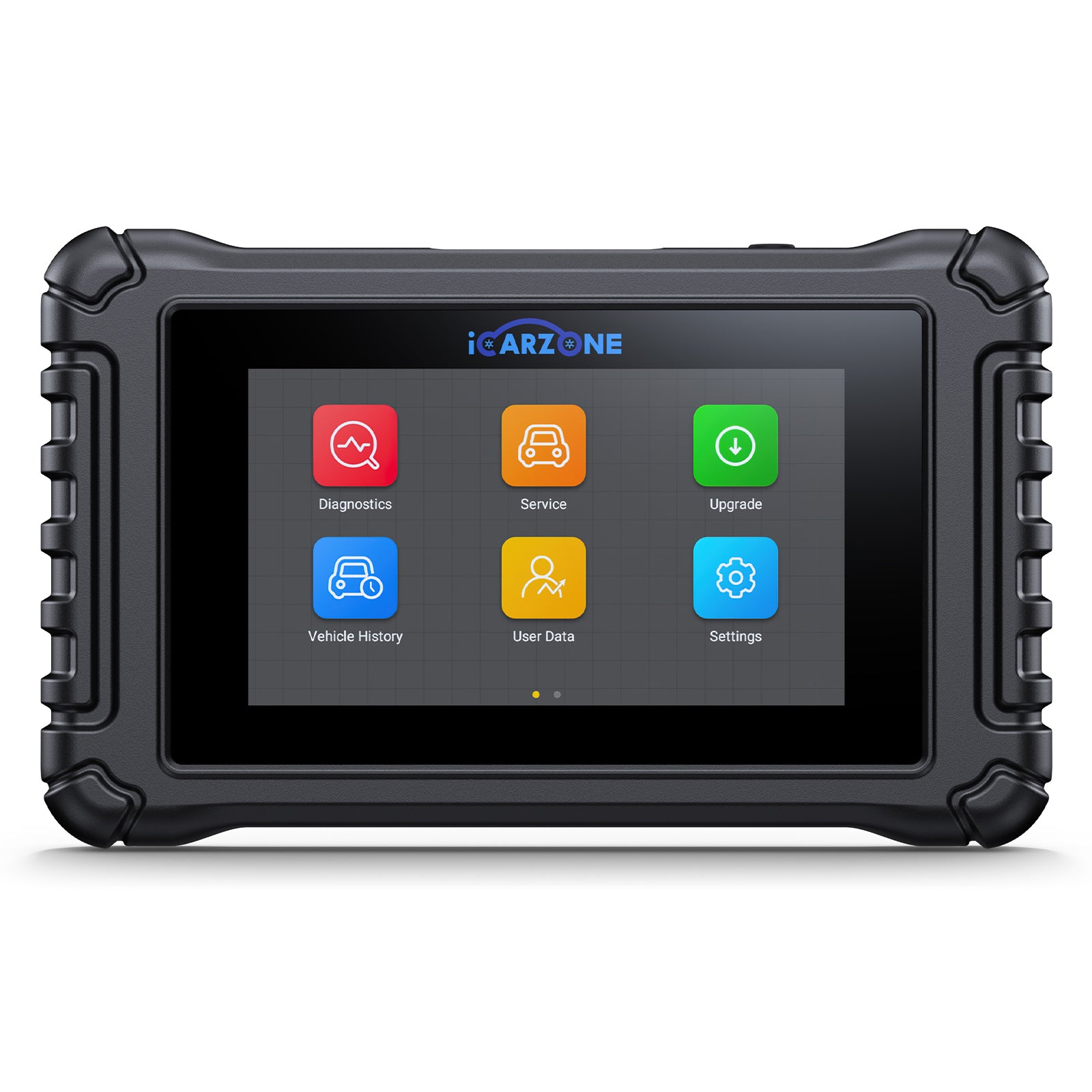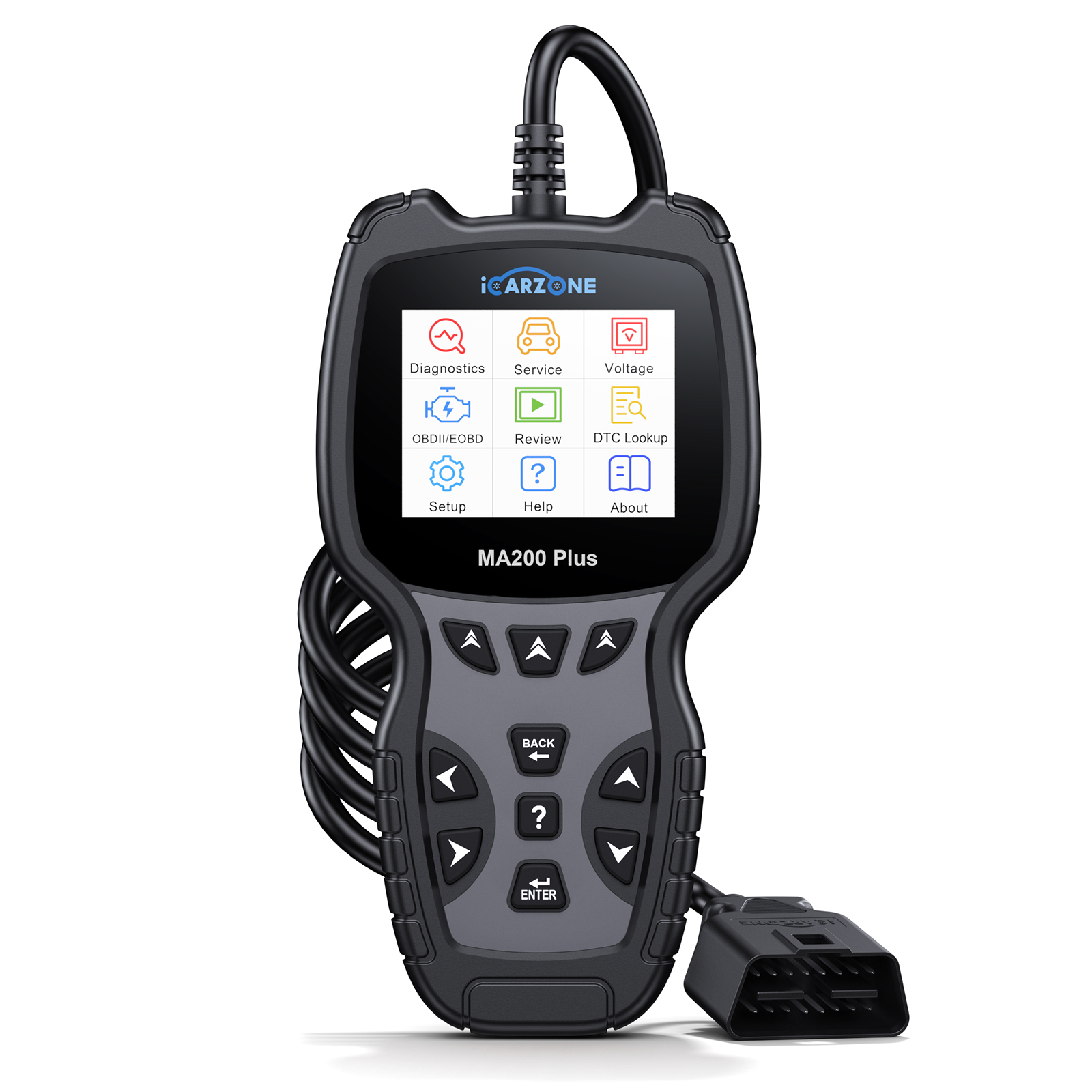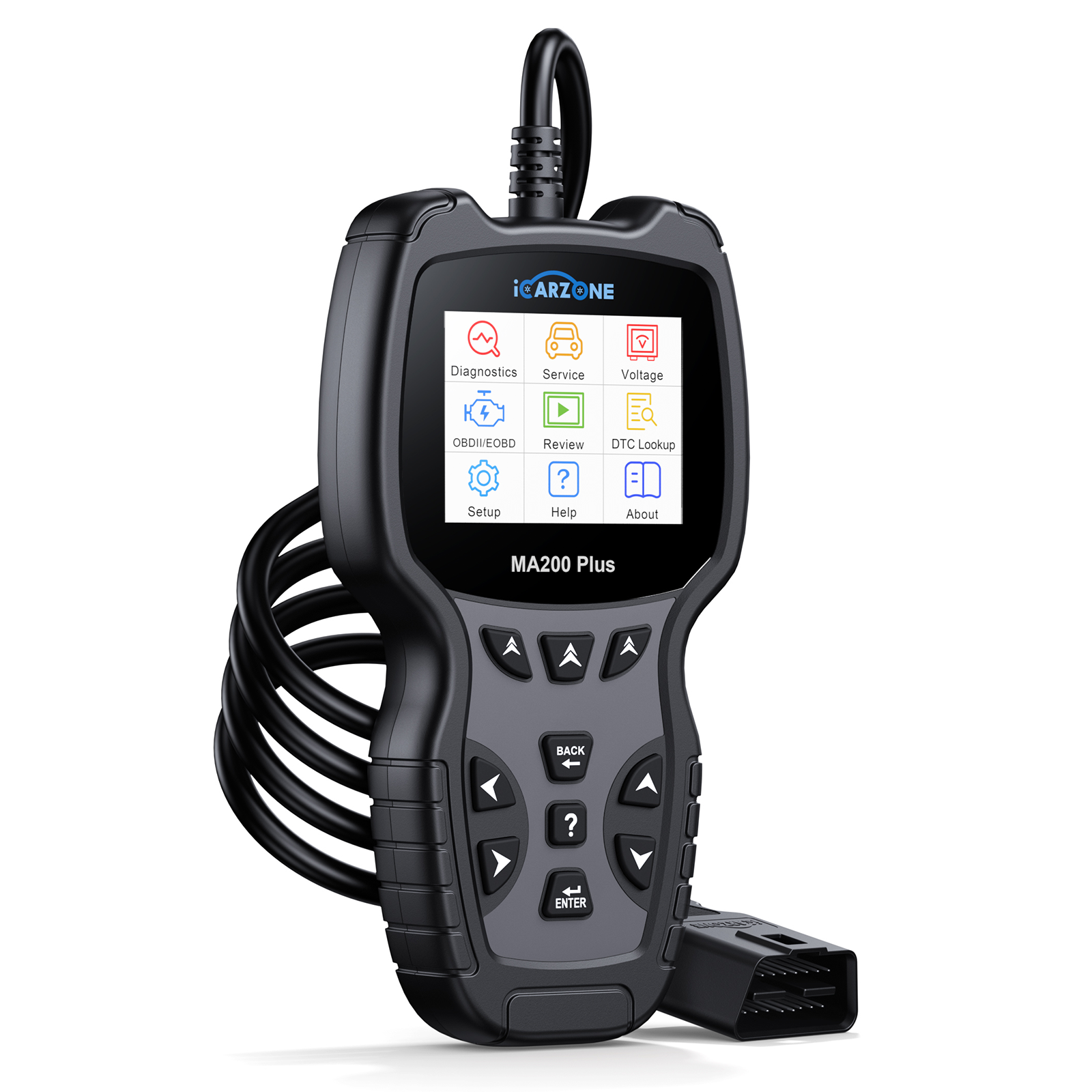P0722 in Ford F-150 (2015-2024): Fix Output Speed Sensor with ICARZONE UR1000
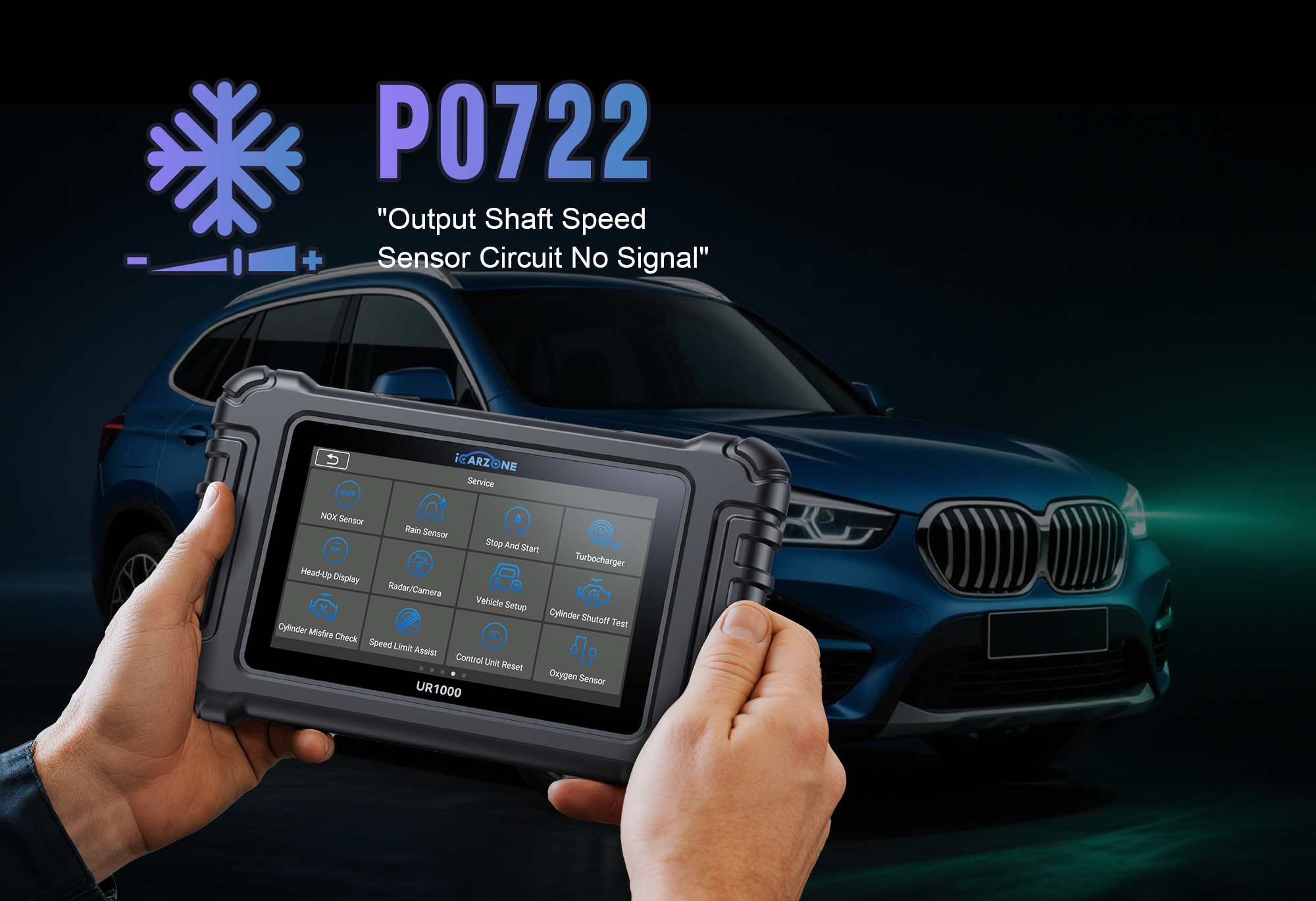
P0722: Output Speed Sensor Circuit No Signal in Ford F-150
Solve P0722 in 2015-2024 Ford F-150 (3.5L EcoBoost, 5.0L V8). Learn causes, symptoms, and fixes using the ICARZONE UR1000 diagnostic tool.
Fix P0722 with UR1000 Now1. What is P0722 in Ford F-150?
P0722 is a transmission-related Diagnostic Trouble Code indicating an Output Speed Sensor Circuit No Signal. In the 2015-2024 Ford F-150, this sensor monitors the rotational speed of the transmission output shaft, providing critical data to the Transmission Control Module (TCM) for proper shift timing and torque converter lockup.
The F-150's output speed sensor generates an AC voltage signal (typically 0.5V-8V AC) that increases with vehicle speed. P0722 triggers when the TCM detects:
- No voltage signal from the sensor for 3+ consecutive seconds while driving above 15 mph
- Signal voltage below 0.2V AC at speeds where 2V+ is expected
- Intermittent signal loss during acceleration or load changes (common in towing scenarios)

Why P0722 Matters for F-150 Owners
The F-150's 10-speed automatic transmission (10R80) relies heavily on accurate speed sensor data for optimal performance, especially in towing and hauling applications. Without this signal:
- The TCM defaults to "limp mode," limiting speed to 45 mph and preventing overdrive engagement
- Transmission shifts become harsh or delayed, increasing wear on clutches and bands
- Towing capacity drops significantly—3.5L EcoBoost models lose up to 40% of their max towing capability
- Fuel efficiency decreases by 2-3 MPG due to improper torque converter lockup
2. Common Causes in 2015-2024 Ford F-150
P0722 in the F-150 is strongly linked to transmission heat, towing stress, and sensor location vulnerabilities—here are verified causes with real-world owner case studies:
- Sensor Failure Due to Transmission Heat (2021 F-150 3.5L EcoBoost) — Example: A 2021 F-150 owner with 65,000 miles developed P0722 after towing a 7,000-lb trailer through mountainous terrain. ICARZONE UR1000's Transmission Sensor Test confirmed no signal from the output speed sensor. Inspection revealed heat damage to the sensor's internal windings—a known issue when 10R80 transmission temperatures exceed 230°F. Replacing with the upgraded 2023+ sensor (Ford #BL3Z-7H103-B) resolved the issue.
- Damaged Wiring Harness (2018 F-150 5.0L V8) — Example: A 2018 F-150 owner reported intermittent P0722 during off-roading. UR1000's Continuity Test showed fluctuating resistance in the sensor wiring. The harness had rubbed against the transmission crossmember (a known F-150 weak point), causing insulation damage. Repairing with Ford's revised harness (#BL3Z-14A411-AA) with added protective sleeving fixed the problem.
- Corroded Connector (2019 F-150 XLT 3.3L V6) — Example: A 2019 F-150 in a coastal area displayed P0722 after heavy rain. UR1000's Connector Voltage Test showed 0V at the sensor connector. Saltwater intrusion had corroded the 3-pin connector (Ford #BL3Z-14S411-A), breaking the signal path. Cleaning with electrical contact cleaner and applying dielectric grease restored functionality.
- TCM Software Glitch (2022 F-150 Lightning) — Example: A 2022 Lightning owner experienced P0722 with no hardware issues. UR1000's TSB Lookup identified Ford TSB 22-2289, which addresses false P0722 triggers in early Lightning models. Updating the TCM firmware to version 1.18 via UR1000 eliminated the code.
- Mechanical Damage from Off-Roading (2020 F-150 Raptor) — Example: A 2020 Raptor owner developed P0722 after rock crawling. UR1000's Live Data showed no speed signal despite proper wiring. Physical inspection revealed the sensor had been damaged by debris, with its tone ring partially bent. Replacing both the sensor and tone ring (Ford #BL3Z-7H103-A and #BL3Z-7G361-A) resolved the issue.

3. Key Symptoms in Ford F-150 Models
P0722 symptoms in the F-150 vary slightly by transmission type but share core performance issues—here's how they manifest:
10R80 Transmission (2017-2024)
- Check Engine Light + "Transmission Malfunction" message in instrument cluster
- Harsh 1-2 and 2-3 shifts during acceleration
- Torque converter fails to lock up (noticable RPM flare at 45-55 mph)
- Limited to 45 mph in "limp mode" after 5-10 minutes of driving
- Towing mode unavailable (grayed out in infotainment system)

6R80 Transmission (2015-2019)
- Check Engine Light + flashing overdrive light (on column shifters)
- Delayed shifts when accelerating from stop
- Inability to shift into overdrive (stuck in 5th gear)
- Speedometer inaccuracy or complete failure
- Reduced fuel economy (2-3 MPG drop on highway)
4. F-150 Engines/Trims Prone to P0722
Ford service data and F-150 owner forums highlight these configurations with highest P0722 incidence, due to usage patterns and transmission stress:
| Engine | Model Years | Transmission | % of P0722 Cases | Primary Risk Factor |
|---|---|---|---|---|
| 3.5L EcoBoost V6 | 2017–2024 | 10R80 | 43% | High towing loads + transmission heat |
| 5.0L V8 | 2015–2024 | 6R80/10R80 | 29% | Wiring harness wear from engine vibration |
| 3.5L PowerBoost Hybrid | 2021–2024 | 10R80 | 15% | Software calibration issues |
| 3.3L V6 | 2018–2024 | 6R80 | 8% | Connector corrosion in humid climates |
| Lightning Electric | 2022–2024 | 1-speed automatic | 5% | Early TCM firmware bugs |
Critical TSBs for F-150 P0722:
- Ford TSB 21-2341 (2017–2021 3.5L EcoBoost): Sensor replacement with heat-resistant version + wiring harness upgrade.
- Ford TSB 22-2289 (2022–2023 Lightning): TCM firmware update to v1.18 for false P0722 triggers.
- Ford TSB 20-2115 (2018–2020 5.0L V8): Wiring harness protective sleeve installation to prevent abrasion.
5. Diagnostic Steps for F-150 with ICARZONE UR1000
Diagnosing P0722 in the F-150 requires testing the output speed sensor circuit—here's how to use ICARZONE UR1000 for F-150-specific accuracy:
| Step | Action with UR1000 | F-150-Specific Goal | Pass/Fail Criteria |
|---|---|---|---|
| 1 | Full System Scan > Select "Ford" > "F-150" > Engine & Transmission | Confirm P0722 and check for related codes (P0700, P0720, P0725) | Pass: Isolated P0722 | Fail: Multiple transmission codes (TCM issue) |
| 2 | Live Data > "Transmission" > "Output Speed Sensor" | Monitor signal while driving at 20-30 mph (should show 20-30 RPM) | Pass: Fluctuating RPM matching vehicle speed | Fail: 0 RPM or flatline reading |
| 3 | Advanced Diagnostics > "Sensor Test" > "Output Speed Sensor" |
|
Pass: 1000-1200 ohms + 2.5-3.5V AC | Fail: Out-of-range readings |
| 4 | Component Test > "Wiring & Connector Check" |
|
Pass: <1 ohm continuity + >10,000 ohms to ground | Fail: Open/short circuit |
| 5 | Service Functions > "TSB Lookup" > Enter F-150's VIN | Check for applicable TSBs (21-2341, 22-2289, 20-2115) | Pass: No TSB match | Fail: TSB applies (follow recommended fix) |
Case Example: A 2020 F-150 3.5L EcoBoost failed Step 2 (0 RPM reading) and Step 3 (1800 ohms resistance). UR1000's Heat Stress Test confirmed sensor degradation. Replacing with the upgraded sensor (Ford #BL3Z-7H103-B) and performing UR1000's Transmission Relearn restored proper operation. After a 50-mile test drive with towing simulation, P0722 did not return.
Diagnose P0722 in F-150 with UR10006. Fixes for F-150's P0722
Resolving P0722 in the F-150 requires transmission-specific repairs—here's how to address each root cause with ICARZONE UR1000:

1. Replace Failed Output Speed Sensor (All Models)
- Ensure transmission is cool—wait at least 2 hours after driving.
- Raise and secure the vehicle on jack stands (follow F-150 lift points in owner's manual).
- Locate the sensor:
- 10R80 (2017-2024): Rear of transmission housing, near driver's side
- 6R80 (2015-2019): Passenger side of transmission, above pan
- Disconnect the electrical connector and remove the sensor (10mm socket).
- Install new OEM sensor (Ford #BL3Z-7H103-B for 2017+, #AL3Z-7H103-A for 2015-2016).
- Torque to 15 ft-lbs (over-tightening damages the sensor or housing).
- Use UR1000's Transmission Relearn to calibrate the new sensor (30-minute process requiring specific driving cycles).
2. Repair Damaged Wiring Harness (5.0L V8 Models)
- Identify damaged section (typically where harness contacts transmission crossmember).
- Disconnect battery negative terminal to prevent short circuits.
- Cut out damaged wiring and splice with Ford-spec 20-gauge wiring (#WPT-1339).
- Use heat-shrink connectors and wrap repaired section with abrasion-resistant sleeve.
- Secure harness away from moving parts using Ford's TSB-recommended clips (#N808374-S).
- Verify repair with UR1000's Continuity Test (target <1 ohm resistance).
3. Fix Corroded Connector (Coastal/High-Humidity Areas)
- Disconnect the sensor connector and spray with electrical contact cleaner.
- Use a small wire brush to remove corrosion from pins (avoid damaging them).
- Apply dielectric grease to all pins and inside the connector housing.
- Reconnect and secure with zip ties to prevent water intrusion.
- For severe corrosion, replace the connector (Ford #BL3Z-14S411-A).
- Verify with UR1000's Connector Test to confirm proper signal transmission.
4. Update TCM Software (2021+ Hybrid & Lightning)
- Connect UR1000 to F-150's OBD-II port (under dashboard, driver's side).
- Select "Service Functions" > "TCM Update" > "Load Latest Firmware".
- Ensure battery voltage remains above 12.5V during update (use battery tender if needed).
- Do not disconnect UR1000 or turn off ignition during the 20-minute update.
- After completion, run UR1000's TCM Validation Test to confirm proper operation.
7. Repair Costs & Safety Tips
Safety Precautions for F-150 Owners
- Never attempt to diagnose or repair P0722 while the vehicle is on a single jack—always use multiple jack stands rated for F-150's weight (minimum 7,000 lbs capacity).
- Disconnect the battery before working on sensor wiring to prevent electrical shorts that could damage the TCM ($800+ replacement).
- Allow the transmission to cool completely before removing the sensor—transmission fluid can reach 250°F and cause severe burns.
- Use only OEM sensors for 2017+ F-150s with 10R80 transmissions—aftermarket sensors often fail to communicate properly with the TCM, triggering P0722 again.
- After repairs, clear codes with UR1000 and perform the Transmission Relearn procedure—driving without this step causes premature clutch wear.
- If P0722 triggers while towing, stop immediately and secure the load—continuing to drive can cause transmission overheating and costly damage.
8. Preventive Maintenance for F-150 Owners
Avoid P0722 in your F-150 with these transmission-specific maintenance steps, recommended by Ford engineers:
- Regular Transmission Fluid Changes: Replace fluid every 60,000 miles (45,000 if towing regularly) using Ford-spec MERCON ULV fluid. Low or degraded fluid increases transmission heat, damaging the output speed sensor.
- Inspect Sensor Wiring: Check the sensor harness every 30,000 miles for abrasion, especially where it contacts the transmission crossmember. Apply protective sleeve (Ford #F81Z-14A411-AA) if signs of wear appear.
- Monitor Transmission Temperature: Use UR1000's Live Data to track temps during towing—keep below 230°F. Install an auxiliary transmission cooler if temps consistently exceed this threshold.
- Clean Connector Annually: For F-150s in humid or coastal areas, disconnect and clean the sensor connector yearly. Apply fresh dielectric grease to prevent corrosion.
- Update TCM Firmware: Use UR1000's Software Update Check quarterly—Ford releases updates that improve sensor signal processing, especially for 2021+ models.
- Inspect After Off-Roading: Check the sensor and wiring for damage after off-road excursions—debris can damage the sensor's tone ring or wiring harness.
9. F-150-Specific FAQs
Only short distances (under 5 miles) to reach a repair facility. P0722 triggers "limp mode" which causes harsh shifting and can damage the transmission. Never tow with P0722 active.
Not recommended for 2017+ models with 10R80 transmissions. Aftermarket sensors often have incorrect resistance values, causing TCM communication issues. Use OEM Ford #BL3Z-7H103-B for reliability.
Yes—UR1000 fully supports 2024 F-150s, including the latest 3.5L EcoBoost and PowerBoost hybrid models, with updated software for 10R80 transmission diagnostics.
Most commonly due to incomplete TCM relearn or underlying wiring issues. Use UR1000's Advanced Transmission Test to check for intermittent wiring faults and ensure the relearn procedure completes successfully.
Towing increases transmission temperature and stress on the sensor, often revealing incipient sensor failures. F-150s used for regular towing should have the sensor inspected every 45,000 miles.
Yes—extreme cold (-20°F or lower) can temporarily affect sensor performance. UR1000's Cold Weather Test can distinguish between temporary cold-related issues and actual sensor failure.
10. Summary
P0722 (Output Speed Sensor Circuit No Signal) is a critical transmission code in 2015-2024 Ford F-150s, particularly affecting 3.5L EcoBoost models used for towing. Caused by sensor failure, wiring damage, or corrosion, P0722 leads to harsh shifting, reduced performance, and potential transmission damage if ignored.
The ICARZONE UR1000 simplifies F-150-specific diagnosis with tools like live transmission data monitoring, sensor resistance testing, and TCM software updates. Most P0722 cases are resolved with sensor replacement or wiring repair—avoiding expensive dealer visits. By following preventive maintenance steps (e.g., regular fluid changes and harness inspections), F-150 owners can maintain proper transmission function and prevent P0722 issues.
Fix P0722 in Your Ford F-150 with ICARZONE UR1000
UR1000 includes F-150-specific transmission tests, TSB updates, and sensor relearn procedures—perfect for 3.5L EcoBoost, 5.0L V8, and hybrid models. Diagnose and repair your truck with professional-grade tools.
Get UR1000 for Your F-150 Today© 2025 iCarzone. All rights reserved.


